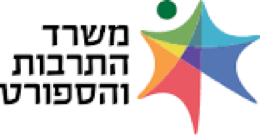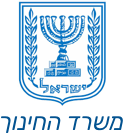The Breslov Gathering on Rosh Hashana in the Hall of the Chachmei Lublin Yeshiva
By: Rabbi David Avraham Mandelbaum son of the genius chassidic Rabbi Bentzion Moshe Meir z”l, a student of the Chachmei Lublin Yeshiva
Among the multitude of miraculous and clearly incomprehensible things that happened around Rabbi Meir Shapira’s short and stormy life, there is the inner bond that resonated with the followers of Breslov in general, and the opening of the doors of the yeshiva in Lublin to them for their gathering during the High Holidays in particular.
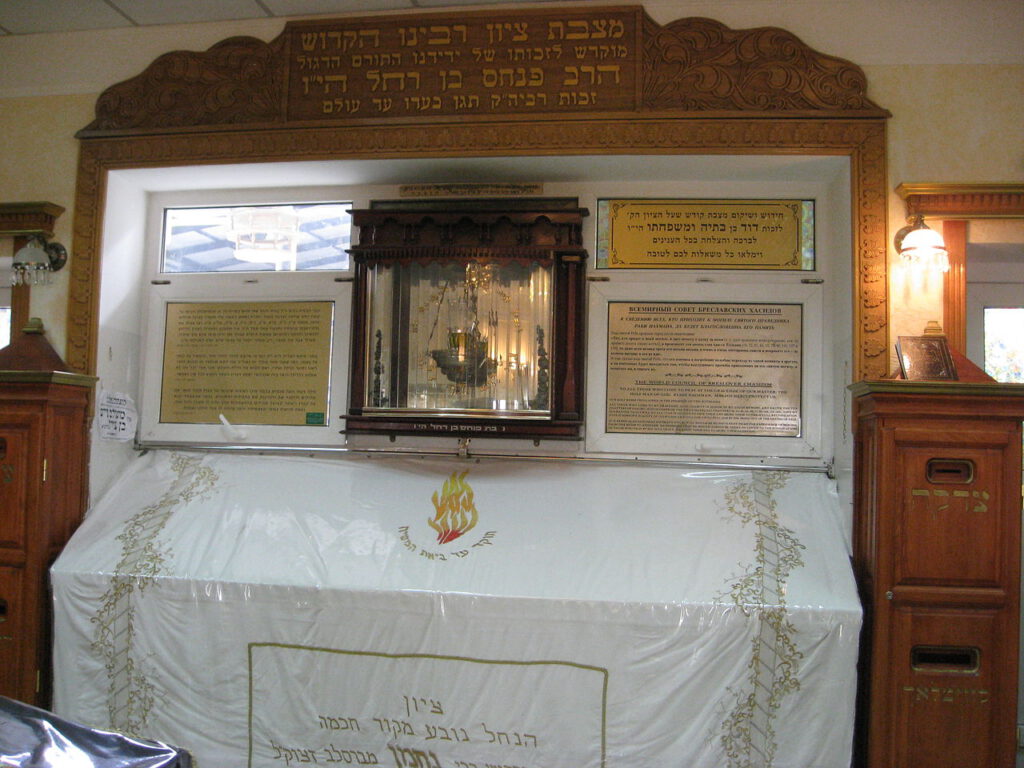
The tomb of Rabbi Nachman of Breslov (courtesy of Wikipedia)
We present here descriptions of the Breslov gathering at the Chachmei Lublin yeshiva, as described by various authors.
In the town of Gur (Gora Kalwaria), our Rabbi, Rabbi Meir Shapira, came to the holy room of the Gerrer Rebbe, the Imrei Emet z”l, as was his custom, to ask advice of the man of G-d and receive advice and encouragement.
And here Rabbi Shapira noticed that the Rebbe z”l was sitting with the book “Likutei Maharan” by Rabbi Nachman of Breslov z”l open in front of him..
The Rebbe immediately noticed the embarrassment on Rabbi Shapira’s face, and the Rebbe z”l got up from his chair and told Rabbi Shapira to wait a moment, went into the inner room and came out with a manuscript in his hand.
It was a volume written by the rabbi of Koritz. The Rebbe showed a passage from the manuscript to Rabbi Shapira, and Rabbi Shapira’s face lit up.
Let’s explain the matter, in the book Imrei Pinchas of the Rabbi of Koritz (in some editions) there is a passage that means that there was a disagreement among the righteous, the rabbi of Koritz and and the Breslover Rebbe, and due to the fact that Rabbi Shapira was the grandson of the rabbi of Koritz, he was embarrassed when he saw the Rebbe studying in the book Likutei Maharan. The Rebbe, who understood the matter, got up and showed Rabbi Shapira that in the manuscript that he had, the words were written in the opposite way, that there was a great appreciation and admiration between the Rabbi of Koritz and the Breslover Rebbe – and as a result, Rabbi Shapira’s face lit up.
From the words of the genius Rabbi Alter, and also heard by the genius Rabbi Moshe Lifshitz z”l from the Rebbe, the Pnei Menachem (from his student, the chassidic Rabbi Rafael Rosenbaum)
*
We will now move on to a meeting of a group of Breslov chassidic leaders in Poland, Rabbi Aharon Leib Zigelman, Rabbi Yitzchak Breiter, Rabbi Yitzchak Meir Korman and others, which took place in the summer of 5690 (1930) in Warsaw (Aish Tamid Toked pg. 522). The topic on their agenda was very critical.
The gathering Breslov chassidim hold in the city of Uman around the time of Rebbe Nachman’s yahrzeit (anniversary of death), based on his instructions, is well known.
Until Rosh Hashana 5679 (1918), the chassidim from all over Europe crossed the border into Russia, every Rosh Hashana eve. They made their way to Uman to prostrate themselves upon the tomb of Rebbe Nachman, in his honour. This was without any problems. The gathering in Uman, the chassidim said, was a rare gathering of chassidim who ascended to very high worlds and their prayer was done with great fervor and tears.
However, in the year 5679 (1918), an “iron curtain” arose in the heart of the rulers of Russia, and this separated Russia from other countries. From this point on, the chassidim did not have the possibility to cross the border and reach Uman. The chassidic Rabbi Yitzhak Breiter, one of the most important Breslov chassidim and of its main influencers in Poland in those years, concentrated the chassidim into the capital city of Warsaw, and organized the gathering there – the first time that it was not in Uman.
Indeed, among the chassidim there were also those who, in their determination to prostrate themselves upon the tomb of Rebbe Nachman, put the outmost effort, particularly as Rosh Hashana approached, as they did not want to submit to the decree of the Russian government; they sought to maintain the gathering in Uman at any cost, and made their way towards communist Russia, trying every way to cross the border. Sometimes they succeeded, and sometimes they didn’t and returned empty-handed, or were imprisoned in a Soviet prison. In any case, great danger always hovered over them.
As the danger worsened, the Rosh Hashana gathering in Uman became an unattainable concept. The chassidim surrendered to the decrees of the times, and looked for an alternative place to hold a gathering, where the spirit of the Rebbe would bless them from afar.
At one point, Rabbi Aharon Leib Zigelman brought up the idea of gathering from all over Poland to the city of Lublin. There were several reasons for this, the first reason was that he lived there and the “Chozeh of Lublin” also lived there, who was known to give an approbation for the Likutei Maharan book. As well, according to Breslov tradition, Rebbe Nachman met with the Chozeh (see in the book Amudei Or) in the city. Many great Torah scholars were buried there such as the Maharam of Lublin, the Maharshal, Rabbi Shalom Shachna, and more. Furthermore, Rebbe Nachman wrote in his works that it is of great importance to prostrate on the graves of righteous people on the eve of Rosh Hashanah.
And thus, on Rosh Hashana 5688, Breslov chassidim gathered from all over Poland in Lublin, and as it was written in a letter by one of the participants, Rabbi Elchanan Spektor:
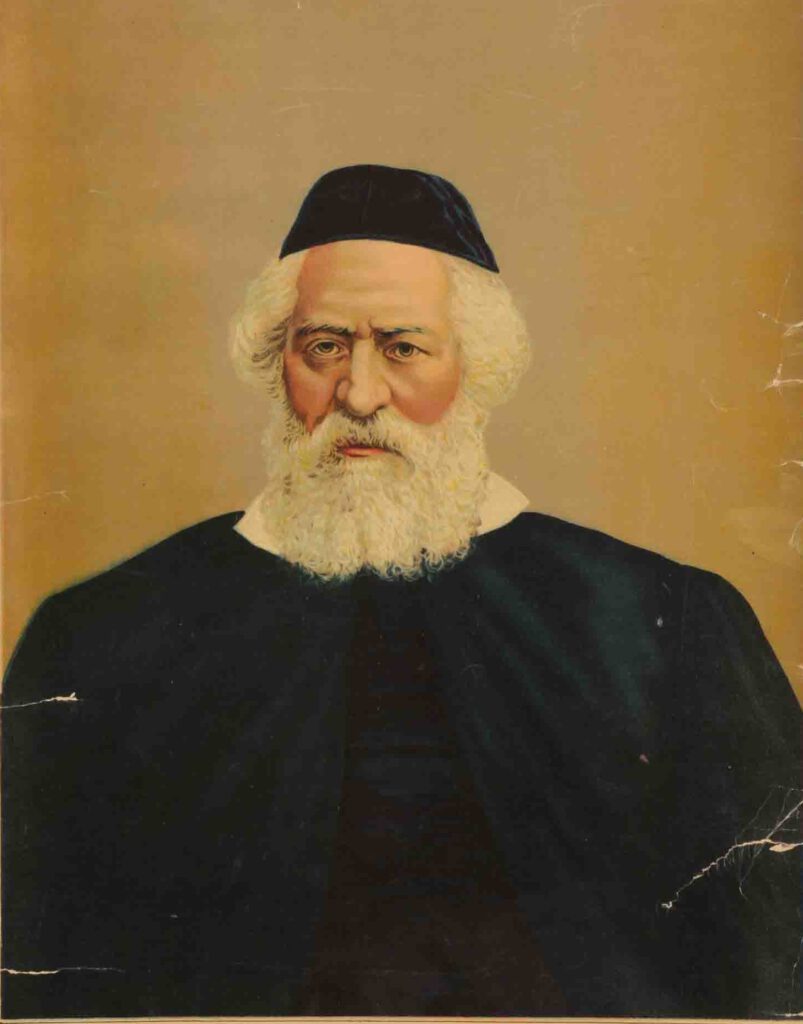
Rabbi Elchanan Spektor z”l from Kovno in his rabbinical garb
“When Rosh Hashanah arrived in the year 5688, all the Breslov chassidim in Poland flocked to Lublin. – On trains, buses, in small boats through the Vistula River, they gathered with wonderful devotion in Lublin, worth six hundred people. The awakening there in prayers, Torah learning, and dancing – is unimaginable. Praised is the eye that sees this!”
The prayers were initially held in the Chozeh of Lublin’s study hall (Kisufim pg. 161), and a year later when the place was too small, they moved to pray in the building of the tobacco factory of the Krasotsky brothers (Aish Tamid Toked pg. 147).
But even then they saw that the place was cramped, and the accommodation and eating conditions there were not adequate, and the public found it difficult to continue in this manner.
And for this, as mentioned, the group of chassidic leaders gathered and discussed the matter.
Rabbi Yitzchak Meir (Itche) Korman took the floor and explained to his friends the original idea that came to his mind, it was right after the inauguration of the Chachmei Lublin yeshiva was celebrated by the majority of the people and in the presence of thousands of Jews on the 28th of Sivan, and he explained: After all, most of the students of the yeshiva belong to the chassidic community, and on Rosh Hashanah days they usually travel to their rabbis, and yet the yeshiva building is almost empty; we ask the head of the yeshiva, Rabbi Meir Shapira z”l, to allow the chassidim of Breslov to pray to G-d between the walls of the yeshiva, where it is spacious, so they can stay together as our Rebbe Nachman wished.
There were among the participants in the meeting those who raised their concern that Rabbi Shapira would not agree to give them the building, since they had only just inaugurated the yeshiva, everything was clean and new, and how would he now agree to let hundreds of chassidim into the building with all that it would imply.
A debate developed on the matter, and it was decided to draw up an emotional letter of request and send it by a personal messenger, Rabbi Yitzchak Meir Korman, in which the chassidim explained all the ups and downs of their situation regarding the gathering, and asked for the help of Rabbi Shapira. The letter was delivered to Rabbi Korman, who was a relative of Rabbi Shapira (see the book Amudei Or), as Rabbi Korman’s wife and Rabbi Shapira were cousins.
On the 11th of Av 5690 (Aug. 5, 1930), Rabbi Korman appeared before Rabbi Shapira with the letter of request in his hand (Nitzotzot monthly, Tishrei 5677/2017, p. 124).
The participants in the aforementioned meeting did not know that meanwhile, Rabbi Shapira had been with the Gerrer Rebbe, the Imrei Emet, and was amazed by what he say regarding the friendship between the rabbi of Koritz and Rebbe Nachman, and so now was the time to talk to him about the gathering.
The road to the Breslov chassidic gathering at the Chachmei Lublin yeshiva was paved…
Indeed, Rabbi Shapira welcomed Rabbi Korman with great joy and expressed his full approval of the chassidim using the yeshiva building, including the eating of the meals in the dining rooms, etc. And he added and said to Rabbi Korman:
“There is an equation between me and you; you are chassidim without a Rabbi, and I am a Rabbi without chassidim”…
It should be noted that on Rosh Hashana 5691 (1930), the building of the Chachmei Lublin yeshiva was not yet complete, and apart from the magnificent great study hall, the construction was in the final stages and not yet finished (see Aish Tamid Toked pg. 523), and it was a huge sacrifice on the part of Rabbi Shapira to allow hundreds of chassidim in such a situation to come to the building for almost two weeks, (from the first day that the Selichot prayers are recited until the end of Yom Kippur).
Regarding the following years, when the yeshiva was already in its full glory, we can read a beautiful description by the chassid, Rabbi Moshe Borstein z”l of Ruzhin who came to the gathering at the Chachmei Lublin yeshiva (Kisufim pg. 181):
Rabbi Moshe told about the great beauty of the Chachmei Lublin yeshiva building. He told about handsome rooms that were built for the boys who got their own room here for the first time. The rooms were furnished with four beds in each room, and next to each bed was a bowl and basin with water for washing hands.
*
Rabbi Yitzchak Meir Korman z”l, who was a man of action, gave his heart over to this matter, as most of the followers who came from all over Poland were poor people, and the train ride cost a lot of money, and he decided to assemble a delegation to meet with the Polish Minister of Transportation, and ask him to approve a reduction in the price of the trip to the gathering in Lublin, and as presented in the book “Aish Tamid Toked” (pg. 89-90):
“In response to the letter, Rabbi Yitzchak Breiter and Rabbi Gedalya Steinzaltz were invited to a meeting in the middle of the holy Shabbat with the minister in his office in the center of Warsaw. Since they oversaw many things on Shabbat (Code of Jewish Law 306, 6), they both went to the meeting dressed in a chassidic kaftan with a coat over it , since in Poland it is cool even in the summer.”
“Upon entering the office, they were asked to take off their coats. Rabbi Gedalya was a little embarrassed; he did not feel comfortable meeting like this in a Jewish kapoteh (jacket-like kaftan) with the honorable minister, but Rabbi Yitzchak told him ‘Do not be embarassed of Shabbat clothes.'”
“After the minister listened to their request, he became interested: ‘Why are you traveling to Lublin?’ Rabbi Yitzchak began to tell him about the chassidim of Breslov, about Rebbe Nachman’s grave beyond the closed border, and about the gathering in Lublin. His words, which were said gracefully and came from the heart, moved even the Polish minister, who took him by the hand and said: ‘Your request is granted. And I wish all the followers a good trip!'”
“When they left the minister’s house, Rabbi Yitzchak said to his friend: ‘Let’s do a dance!'”
“Afterwards, Rabbi Gedalya told the chassidim about the meeting, full of admiration for the confirmation that was given immediately and without delay, ‘How can you explain something like this to a gentile?!’ The whole thing was crazy.”
“This is how Breslov chassidim in Poland received a significant discount of 75% on a train ride to Lublin.”
And as in written in the book Amudei Or (part 2, pg. 443):
“This event, in which the minister immediately approved the chassidim’s request, moved Rabbi Yitzchak Breiter in a rare way, the ability to convey ‘dem Rebbe’s tzach’ (our rabbi’s interest) – straight from his heart to the heart of a Polish gentile, moved him. It became clear to him with his sense, that the truth and the path of the righteous – the truth – are completely clear concepts to those who do not cover their eyes, so that even a Polish gentile, if he only listens to his heart for a moment, will be moved and say ‘The God of Israel is King.'”
“The whole essence of Rosh Hashanah, said Rabbi Yitzchak, is the day of reigning in the clarity of divine truth, which enlightens even the eyes of the gentiles.”
*
The Arrival to Lublin
A student of the Chachmei Lublin yeshiva, Rabbi David Weisbrod z”l wrote in his book Siach Tzadikim (pg. 107):
“The eager ones amongst the Breslov chassidim arrived before the Shabbat when Selichot services start. There was no need to ask their identity, because their ways were indicative. The sparse amount that they packed, their carefree attire, and the joy on their faces pointed them out as Breslov chassidim. The following days brought with them multitudes of chassidim, while on the night of ‘Zachor Brit’ (the opening night of Selichot services) the Breslov gathering was full, no one was absent. The heads of the gathering reviewed those who came and took care of their accommodations. Crowds flocked to the large study hall of the Chachmei Lublin yeshiva. Lubertowska Street, which leads to the yeshiva, was full of people of all ages flocking to the great gathering.”
And we quote from the description of one of the gathering, from Rabbi Moshe Borstein of Ruzhin (Kissufim pg. 104):
“Little by little, the streets were stripped of their weekday clothing, and the white shone here and there. Another chassidic Jew appeared in a black kittel (chassidic coat), and another wore a bright one. The streets were painted white, asking to be purified and sanctified. Everyone flocked to the great yeshiva.”
“Moshe, who walked among the lambs dressed in gray clothing, was surrounded by excitement. This was his first time in the city of Lublin, and here he was walking and approaching Lubartowska street where the most talked about yeshiva in the chassidic world was located: the Chachmei Lublin yeshiva founded by Rabbi Shapira.”
“And he stood in the yeshiva and watched the wonder: a chassidic yeshiva with the best young men, who get their own building! The students of the yeshiva merited, and Rabbi Shapira built a magnificent and spacious building for them: six floors, one hundred and ten rooms, halls, a kitchen, and a library. Moshe thought about the satisfaction of the students of the yeshiva, and about the Torah that was passionately carried on there, and whose wings were spread far and wide.”
Another student of the Chachmei Lublin yeshiva, the chassidic Rabbi Meir Lamt z”l told (Nitzotzot monthly, Tishrei 5777/2016, pg. 132):
“…What can I tell you! We envied the brotherhood that prevailed among them… I remember them coming in droves and hugging each other’s necks… I was very surprised, because among the participants I also saw beardless Jews… It was a great novelty for me, and in general , the intense love, love without limits that prevailed between them was pulsating…”
*
There was a certain dilemma before Rabbi Meir Shapira, the financiers of the city of Lublin came before him, asking him to pray in the central and ancient study hall of the Maharshal in Lublin, because after all our rabbi served as rabbi of the city of Lublin, and while the students were in the yeshiva – the financiers claimed , they would not have asked for anything, and they would have understood that the rabbi was praying with his students, but since most of the students went to their rabbis, and now Breslov chassidim were praying in the yeshiva, it would be fitting that Rabbi Shapira, as the rabbi of Lublin, should pray in the study hall of the former rabbi of Lublin – the Maharshal.
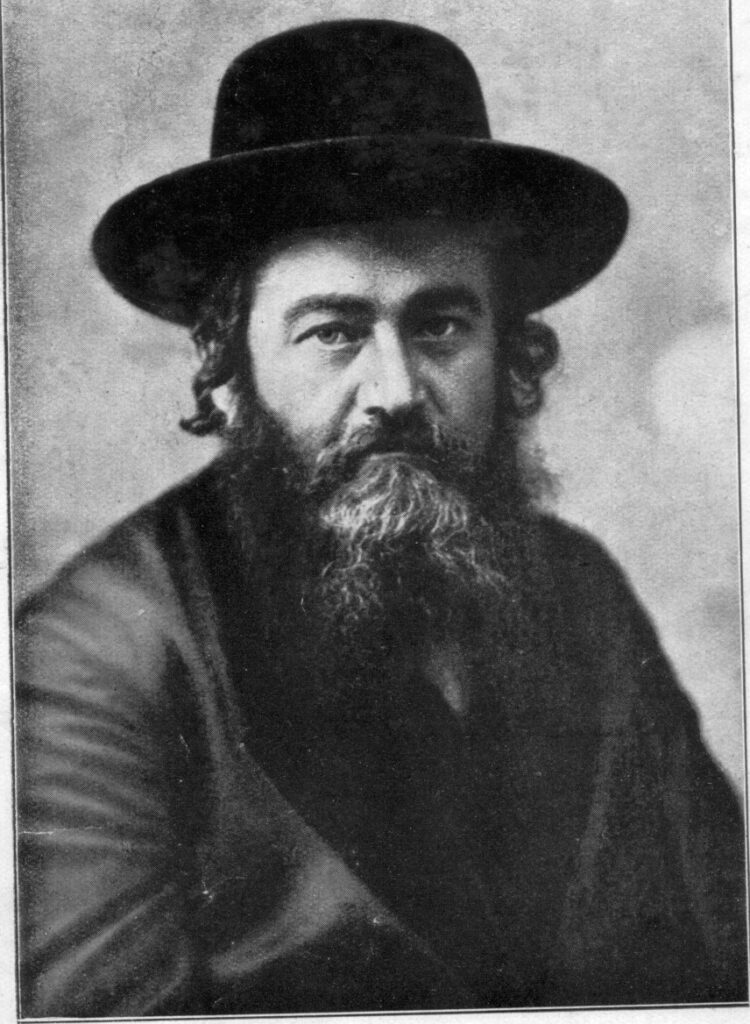
Rabbi Meir Shapira z”l – head of the Chachmei Lublin Yeshiva
Amazingly, Rabbi Shapira replied that he wanted to pray precisely in the yeshiva hall with the Breslov chassidim, and he added:
“Although being Rabbi of Lublin, I should pray with the community on Rosh Hashana, I prefer to resign from my position, provided I don’t lose the prayer with the Breslov chassidim” (Amudei Or pg. 412).
This matter caused a huge response among the public.
The Mincha and Maariv Prayers – Rosh Hashana Night
It states in the book Kisufim (pg. 165 and onwards), from the memories of the chassid Rabbi Moshe Borstein of Ruzhin z”l:
“Rabbi Meir Shapira stood next to the prayer stand, and Rabbi Moshe (the above) was standing next to him, Rabbi Moshe gazed at the face of Rabbi Shapira and its impression inspired him. The royal shreimel (chassidic fur hat) on Rabbi Shapira’s head stood out among the multitude of hats and visers worn by all the other worshippers.”
“Footsteps were heard approaching the stage. Moshe looked up from his prayer book and saw the ‘baal tefila’ (prayer leader), Rabbi Shlomo Yehuda Hoffman, wrapping himself in his tallis (prayer shawl) and approaching with courage and trembling for the Mincha prayer of Rosh Hashana eve.”
“The prayer was permeated with the outpouring of the soul and lofty intentions, mixed with a great devotion to friends and wonderful chassidic sweetness. The participants rose through the ranks, drifted up, and soared with the ‘baal tefila’ to an ancient world of the nation’s holy people. It seems that the souls of all those saints gathered and came there for the Mincha prayer on Rosh Hashana eve. Moshe looked from time to time at Rabbi Meir Shapira, who was standing next to him, at his praying that came from a pure heart, and he was filled with elation.”
“And when the Mincha prayer was over, it was only a break until the next prayer services.”
“The participants began to say the ‘Achot Ketana’ prayer, and Moshe, who was standing next to Rabbi Shapira, began to tremble. Rabbi Shapira’s voice rose and grew stronger, and captured hearts. His voice shook the soul and raised it to enormous heights. There was something rare and sublime in it, in Rabbi Shapira’s prayer.”
“‘The little sister (Achot Ketana), her prayers she prepares and proclaims her praises. Oh G-d, please, heal now her ailments. Let the year and its curses conclude!’ – Rabbi Shapira poured out his heart in prayer. All of it displayed majesty, and all of it expresses holiness, bowing, and prostrating before G-d. And the participants who heard the prayer coming out of the holy mouth did not remain as they were…”
“Their hearts melted, and it was easy for them to adhere to G-d’s standards.”
“During all the years that followed, even when Rabbi Moshe Borstein was close to a hundred years old, his heart would pulse with excitement, and he would always shed true tears when he recited the Rosh Hashanah prayer ‘Achot Ketana.’ The wonderful sight of Rabbi Meir Shapira z”l arose in his memory, the specific subject being this special prayer. ‘Ah! It was a prayer…!’ he would say about that Rosh Hashana in the presence of Rabbi Shapira. And a tear that glistened in the corner of his eye, emotionally moistened the eyes of those present as well.”
“The important chassidim who heard Rabbi Shapira pray the ‘Achot Ketana’ prayer which awoke and pushed the worshipers to high levels, decided at the moment to ask him for their permission, and to serve as a ‘baal tefil'” in the festive Aravit (Maariv) prayer service.”
“The chassidim rejected the tradition of appointing a ‘baal tefila’ from among the Breslov chassidim themselves, since they had never heard the ‘Achot Ketana’ prayer as they had heard from the mouth of Rabbi Shapira. Rabbi Yitzchak Breiter approached Rabbi Meir Shapira and asked them to honour the participants by going up to the prayer stand. Rabbi Shapira responded in the affirmative, and did not hide his satisfaction at the great privilege that befell him to be a ‘baal tefila’ at the gathering of the Breslov chassidim.”
“‘Rabbi Meir Shapira is praying?’ The worshipers trembled in surprise, and their prayer now flowed from the deepest springs of their hearts, and poured out and mixed with the prayers of Rabbi Shapira.”
And the aforementioned rabbi went on to describe the enormous excitement that was in the study hall when Rabbi Shapira stood at the prayer stand during the Maariv prayer on the night of Rosh Hashana:
“And his voice was like a lion’s roar, piercing and electrifying the air.”
“After the prayer, our rabbi opened with a song that he composed with the words ‘Blessed is the man who will not forget You,’ and the whole excited crowd sang this song with him; they sang and were elevated, and there was much joy for a long hour…in a festive way, elevated and with much joy, for a long, long, long hour… in a festive and exhalted atmosphere.”
“Then the whole group passed before Rabbi Shapira, to bless him and to be blessed with a happy new year. And he answered everyone with a smile and with joy and an open mind.”
Rosh Hashana Tunes
It should be noted here what the above-mentioned book, Kisufim, states (pg. 180):
“The tunes for the ‘zachreinu l’chaim,’ ‘be’sefer chaim,’ ‘u’vechen tazdikim,’ ‘ashrei ish,’ and ‘v’yaasu kulam,’ that Rabbi Shapira composed for the high holidays and which were sung at the Breslov gathering in Lublin, became popular Breslov chassidic songs, and are now sung every year before Rosh Hashana, on Rosh Hashanah, as well as on the Ten Days of Repentance (between Rosh Hashana and Yom Kippur). The tunes, which were preserved by the chassidim, survived the Holocaust, and are remembered, out of gratitude, with the name of their composer, Rabbi Shapira.”
The Rosh Hashana Night Meal
Rabbi Shapira returned to his apartment to prepare for the holiday meal together with his students, and several of the distinguished chassidic guests were invited to his table, among them the old chassid Rabbi Bentzion Apter, who was very close to and unusually beloved by Rabbi Shapira.
And a student of the Chachmei Lublin yeshiva, Rabbi David Weisbrod z”l, recounted (in his book Siach Tzadikim pg. 110):
“Rabbi Bentzion sat next to Rabbi Shapira, and countless times repeated the well-known Breslov melody that draws on the verse ‘Your nation, Oh G-d, they crush’ (Psalms 94:5). The melody vibrates the veins of the heart, and the Chachmei Lublin yeshiva students who repeated the melody and helped Rabbi Bentzion broke down in tears. Rabbi Shapira’s eyes also overflowed with tears. In a sad voice soaked with endless longing for something that is gone and hidden, he repeatedly uttered the words: ‘Your nation, Oh G-d, they crush’ – Shechina (G-d’s presence) in exile.”
And thus told a student of the Chachmei Lublin Yeshiva, the genius Rabbi Elimelech Ashkenazi z”l, in his book Ginzei HaMelech (pg. 557):
“And I remember when Rabbi Bentzion used to come to my teacher, the Lubliner (Rabbi Shapira), and Rabbi Bentzion sang before him a tune that was accepted in Breslov, which is from our elder, Rabbi Pinchas Karitzer z”l, on the verse (Psalms 94:5) ‘Our nation, Oh G-d, they crush, and Your inheritance they afflict,’ and Rabbi Shapira listened to the tune.”
It should be noted, what was told by a student of the Chachmei Lublin yeshiva, Rabbi Yehuda Meir Abramovitz z”l, that once on the night of Rosh Hashana, Rabbi Shapira sent him to Rabbi Bentzion Apter and asked him to remind him of it… (from the mouth of his son Rabbi Hanoch – Nitzotzot monthly – Adar 5779/2018 pg. 32).
We will also quote what Rabbi Moshe Borstein z”l told in his book Kisufim (pg. 180) and what he himself heard from the chassid Rabbi Bentzion Apter:
“Rabbi Bentzion Apter once saw his close friend, Rabbi Shapira, walking in front of him on the street. The image of Rabbi Shapira was impressive and dignified – besides being the rabbi of the city and the founder of the Chachmei Lublin yeshiva, he was also a member of the Polish Sejm (parliament) and his dress was meticulous and dignified as befits his position. Rabbi Bentzion Apter, who was dressed as a simple chassid, and perhaps his clothes were faded and old, feared that Rabbi Shapira might be ashamed of him as a friend, and moved to the other side of the street so as not to run into him and not be forced to greet him in front of people on the street.”
“Rabbi Meir Shapira, who saw Rabbi Bentzion on the other side of the street, also crossed the street and called out: ‘Bentzion, are you ashamed of me?'”
Shofar Blasts and the Musaf Prayer
In the book Amudei Or (pg. 425) the words of a Chachmei Lublin yeshiva student, Rabbi David Weisbrod z”l, are quoted:
“Preparing for the shofar blasts: The influential amongst the chassidim surrounded the chassid, Rabbi Ephraim Krakowski – a lofty righteous man, amongst the higher ups of Breslov chassidism – and inclined their ears to the hints of the shofar blasts coming from his mouth.”
“Another group closely follows the movements of Rabbi Pinchas’l of Przedbórz, who, according to the chassidim’s testimony, should have led a large congregation of chassidim. He was a character who is was not materialistic at all. One of Rabbi Pinchas’s interests was the recitation of ten chapters of Psalms set by Rebbe Nachman, and he dedicated himself to spread the idea of the ‘Tikkun HaKlali’ (book by Rebbe Nachman). Rebbe Nachman had the privilege of discovering one of the hidden secrets of repentence, and said that by saying the ten chapters of the Psalms, one corrects the brokenness!”
“On the occasion of th gathering of thousands in Lublin, Rabbi Pinchas’l found a large area to give over his holy words.”
“Rabbi Pinchas, in his simpleness, approached Rabbi Shapira, and influenced him, with G-d’s help, about the importance of the ‘Ten Kapitalach’ (ten chapters of Psalms).”
“Rabbi Shapira received the suggested with great joy, and when Rabbi Itche Meir Korman, approached the stand to say the psalms, he found Rabbi Shapira at his side.”
“Rabbi Pinchas’l’s face beamed with joy, he was able to create one unified soul regarding Rebbe Nachman’s idea.”
“As early as the day before, the heads of the congregation approached Rabbi Shapira, and honored him with the shofar blasts. The choice was accepted with understanding and agreement as a matter of course.”
“In the meantime, Rabbi Shapira went to the mikva house (ritual bath) and immersed. He got out, dried himself, put on a kittel, fastened his sash, wrapped himself in a tallit, countless shofar blasts under his belt, and with slow steps made his way to the elevated prayer platform.”
“Those close to him felt his great efforts to quite the naysayers. His sidelocks fluttered and flew in the light breeze that blew through the open windows. Beads of sweat covered his face, which took shape and changed shades. His teeth chattered, and his entire body trembled. A terrible tension prevailed in the study hall, when Rabbi Shapira brought the shofar to his mouth to sound the blasts.”
“Tekia…” (one of the types of blasts)
“A clear and sharp voice came out of his pure mouth, without interruption and without flaw, otherworldy.”
“The gates of mercy were opened and the way was cleared for the Musaf prayer.”
“Rabbi Shapira’s shofar blasts made a great impression; his blasts were blessed with a rare sharpness and clarity.”
In the monthly Nitzotzot (Tishrei 5777/2016 pg. 137) the letter of the well-known chassid, Rabbi Elchanan Spektor z”l, is quoted:
“I clearly remember, the rabbi z”l, who was the shofar blower, blew wonderously wirh a very clear note without any delay, only short and very fast notes…”
Tashlich
It states in the book “Amudei Or” (pg. 428):
“Lublin has not seen such an event since the days of Rabbi Shalom Shachne. Crowds streamed from their hostels towards the Bystrzyca River. It was time for Tashlich in Lublin. On the sides of the roads, Jewish Lublin stood, ten thousand Jews, bowed, trembling, waiting for the appearance of our Rabbi Shapira and his students accompanied by the Chassidim of Breslov.”
And we will continue with the description by Rabbi Borstein from the book Kisufim (pg. 173):
“Rabbi Shapira marched to recite Tashlich. He marched through the streets of the city like a king in a regiment. After him marched crowds of Jews dressed for the holiday, walking closer to the Bystrica river, to throw away all their sins.”
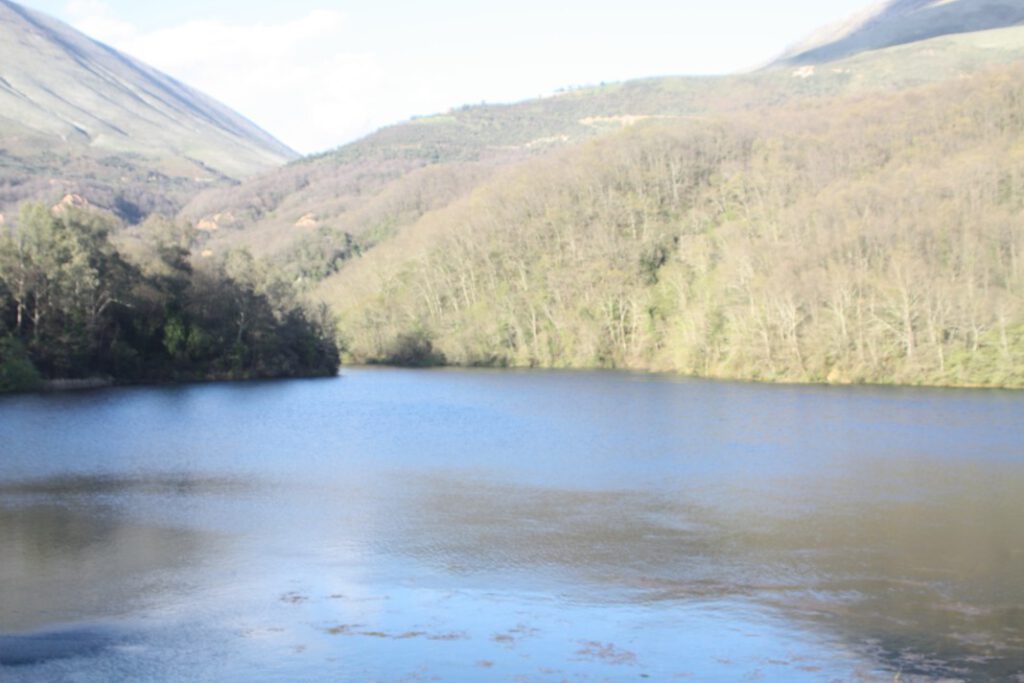
The Bystrzyca River (courtesy of Wikipedia)
“The crowd sang and marched, marched and sang ‘the the King of kings above his creation,’ and continued marching to the purifying river. Such a festive and joyful procession was not seen every day in the streets of Lublin. The singing echoed into the distance, engulfing in its lines the footsteps of the marchers, the chirping of the birds, and the whispering of the wind. Only the song of the Jews praying before G-d was heard there on the street of the city.”
“The huge crowd danced and sang, and the eyes of the gentiles were full of wonder.”
The author, Rabbi Yechiel Gerenstein z”l, from Lublin, also described the scene (in the book Netzer Mashorashav about the student of the Chachmei Lublin yeshiva, Rabbi Menachem Mendel Weitz, pg. 128):
“The head of the yeshiva, the rabbi of Lublin, was accompanied by his students and members of his community, and they all marched en masse towards the Vistula River. All the Jews of the city watched this wonderful sight, and even the gentiles who lived in the city looked at the spectacle through the windows of their houses, and their eyes were surprised to see what the king of the Jews looked like walking down the street of a city accompanied by his legions”.
The Dancing after Tashlich
It states in the book Amudei Or (pg. 325):
“Following Tashlich (when sins are symbollically tossed into the water), the public was divided into two sects: Those who went to hear Rabbi Bentzion Apter, and the rest who turned to hear his influential friend, Rabbi Yitzchak Breiter. Both of them spoke passionately and upliftingly about the sanctity of the days, and about the Rosh Hashanah articles in the book Likutei Maharan.”
“Rabbi Shapira also used to go down to listen to the speech of his friend Rabbi Bentzion. When he kissed his head at the end of his speech, during the last year of Rabbi Meir z”l’s life, Rabbi David Weisbrod z”l testified: ‘His excitement overcame him, and he started dancing with Rabbi Bentzion in the middle of the circle with great excitement.'”
This is how Rabbi Motel Yegelnik z”l described it (Shearim – 16 Shvat 5734/8 Feb. 1974):
“And then the dancing began before Maariv, and Rabbi Meir Shapira danced with Rabbi Bentzion together with all his students and followers. And those who have not seen these dances have never seen dancing in their lives. It is impossible to describe with a human pen the joy of the dances, and the joy was with crying, mostly out of joy and longing for G-d.”
In the monthly Nitzotzot (Adar 5779/2019 pg. 32) Rabbi Chanoch Abramovitz told what his father, a student of the Chachmei Lublin yeshiva, Rabbi Yehuda Meir z”l, told him:
“Rabbi Shapira loved Rabbi Bentzion in an unusual way, and in the middle of the stormy dances, Rabbi Shapira gave his holy hand to Rabbi Bentzion and danced with him, and the rabbi did not feel it at all, because when he danced he was completely stripped of his judgment and did not pay attention to the dancers around him, and after two hours of dancing Rabbi Bentzion felt that his hand rested in the hand of Rabbi Shapira, and this while he was rolling up his sleeve to wipe the sweat from his face…”
The Night Rosh Hashana Ended
In the monthly Nitzotzot (Tishrei 5771/2010 pg. 137), a wonderful description by the chassidic Rabbi Nachman Albaum z”l, who came with the Breslov chassidim to the gathering in Lublin, is presented:
“On the night when Rosh Hashana ended, at the gathering in Lublin, after two days of prayer that erupted from the depths of the soul, and lifted the worshipers to the summits, everything was held together in a dance of farewell, a well-known dance, in which Breslov year after year instilled the essence of her soul upon. Here in Lublin, in the holy yeshiva hall, in front of hundreds of ‘uncircumsized ones’ of Lublin, who peered curiously from the windows, things took on a dimension that was beyond the reach of judgment:
Tayereh brider, hertizgeh brider (Dear brothers, heartful brothers)
Ven velen mir zich vider zen? (When will we see each other again?)
Ay, ven velen mir zich vider zen… (Hey, when will we see each other again)”
“Tears of happiness, feelings of exaltation, and the anguish of parting, which only Breslov knew how to blend into one dance, mingled there in a huge noise with the thunder of singing and dancing. Thousands of Jewish souls, and Rabbi Shapira at their head – roared, cheered, and expressed the agony of parting in the Breslov way:
Az G-tt vet geben gezunt un leben (That G-d will give health and life)
Velen mir zich vider zen (When will we see each other again)
Az G-tt vet geben gezunt un leben” (That G-d will give health and life)”
“They truly said, that the official and spiritual aspects of the gathering in Lublin took root and clung to the hearts of the thousands of participants throughout the entire year.”
And we will end with the words of a student of the Chachmei Lublin yeshiva, Rabbi Yehuda Meir Abramowitz z”l, the author of the book Ish Chai Rav Pe’alim (pg. 72):
“The days of Rosh Hashanah, when more than a thousand Breslov chassidim came to their gathering at the Chachmei Lublin yeshiva, were days of exaltation and holiness. It is difficult to describe the prayers, the joy, and the dancing, which gave the holiday an uplifting and special atmosphere.”
At the end of this article, I must mention the genius righteous Rabbi Natan Tzvi Koenig z”l, head of the Breslov Kollel (yeshiva for adult men) in Bnei Brak, who introduced me to the magical world of the Breslov gathering at the Chachmei Lublin yeshiva, and enlightened me on the subject, and at that time I printed a little bit of the matter in my book on the Chachmei Lublin yeshiva (pg. 119 and onwards).
Rabbi Natan Tzvi Koenig z”l passed away in his best years, on 27 Tishrei 5758 (Oct. 28, 1997), and returned his soul to his Creator right while perusing the above-mentioned books on the Chachmei Lublin yeshiva, which he was very fond of (according to his son-in-law, Rabbi Sternbuch). May his memory be blessed.
